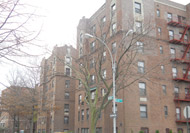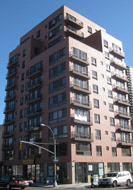|
COVER STORY, JULY 2012
FANNIE MAE STEPS FORWARD
The agency’s multifamily loan portfolio assists in the first positive quarter since
conservatorship.
By Matt Valley and John Nelson
Government-controlled mortgage lending agency Fannie Mae posted net income of $2.7 billion in the first quarter — the first positive quarterly results since the company was put into conservatorship in September 2008. Fannie Mae had fewer real estate owned (REO) single-family properties on its books during the quarter and there was a less significant decline in sales prices for REO houses compared to fourth quarter 2011.
The agency’s single-family inventory headlined the turnaround, but the firm’s multifamily loan portfolio had a hand in the company’s recovery thanks to a minimal delinquency rate and an increase in loan originations. Fannie Mae lenders financed 117,000 multifamily units in the first quarter compared to 83,000 units financed in the first quarter of 2011.
“2012 is off to a strong start with $7.2 billion in financing through the first quarter,” says Manny Menendez, vice president and head of multifamily customer engagement at Fannie Mae. The dollar amount is up 44 percent from the same period last year.
“Multifamily is profitable on a segment reporting basis with low credit losses and delinquencies, and our market fundamentals are generally favorable,” he adds.
The positive momentum and low delinquency rate of Fannie Mae’s multifamily loans — 0.37 percent as of March 31, 2012 — is all the more impressive considering the uncertainty surrounding the future of Fannie Mae and Freddie Mac. The agencies’ assets and operations have been under the control of the Federal Housing Financing Agency (FHFA) since 2008. The FHFA has put constraints on the agencies and is in control of their operations for the foreseeable future.
In addition to conservatorship, Sen. Bob Corker (R-Tenn.) and Sen. Johnny Isakson (R-Ga.) have proposed legislation in Congress that — if passed — would eliminate Fannie and Freddie after a 10-year transitional period that would end in the privatization of the resulting agency. Also, several key members of Fannie Mae’s executive staff — including CEO Michael Williams — have decided to step down, changing the makeup of the company and casting a shadow on the future.
The company recently named Timothy Mayopoulos as the new president and CEO of Fannie Mae. Mayopoulos previously served as Fannie Mae’s executive vice president, chief administrative officer and general counsel.
Despite the changing of leadership and general uncertainty, Fannie Mae is still conducting business at a high level. Fannie Mae’s mortgage origination volume in the multifamily sector totaled approximately $24 billion in 2011, a 46 percent increase from 2010. Additionally, Fannie Mae controls 21.2 percent of the $840.8 billion market share of multifamily debt outstanding, according to the Federal Reserve.
“We try to focus on the things we can control — operating our business soundly, being a constant source of liquidity for our lenders and making sure we’re supporting the multifamily market,” says Menendez. “Ultimately, decisions about the future will be made by others. Sometimes that is a challenge, but we try to remain focused on our role and the important work we have to do every day.”
Brian Ranallo, COO of St. Paul, Minnesota-based Oak Grove Capital, a Fannie Mae DUS lender, says the intense scrutiny that Fannie Mae and Freddie Mac are under could be viewed by the GSEs as positive because their multifamily operations continue to be profitable.
Ranallo points out that there is an element of uncertainty in every industry. “Our strategy is focused on the areas of the business that we can control,” Ranallo says, echoing the comments of Menendez.
 |
Beech Street Capital provided $25.9 million in Fannie Mae DUS loans for the refinance of a seven-property, 530-unit multifamily portfolio located in Brooklyn, Queens and the Bronx in New York City. The portfolio includes 175-27 Wexford Terrace (pictured) in the Jamaica submarket. The fixed-rate loans have a 7-year term, 6.5 years of yield maintenance and full-term interest-only. Meridian Capital Group originated the transaction. |
|
“Fannie is sort of countercyclical to the market. When the market expands and more lenders come in with aggressive underwriting, Fannie does less business,” says Michael Edelman, senior vice president of production management in Beech Street’s New York office. “When it’s more conservative underwriting and more realistic expectations and pricing, they’ll do more business.”
Edelman, a former managing regional director at Freddie Mac, is responsible for the oversight of Beech Street’s production in the Northeast. Beech Street’s Fannie Mae volume is 65 percent refinancing and 35 percent acquisition financing, according to Edelman.
The volume of acquisitions, as well as asset prices, are trending upward, therefore Beech Street’s Fannie Mae business may be closer to 60 percent refinancing and 40 percent acquisition financing by year’s end.
Edelman believes Fannie Mae’s multifamily business is more buoyant than other lenders’ because the agency didn’t get too hot or cold through fluctuations in the market.
“Fannie never lent aggressively in the overheated market, and therefore its portfolios have held up well,” says Edelman. “They never really changed their lending parameters through the ups and downs of the market.”
Capital Competition
The multifamily sector remains the darling of the investment community due to solid real estate fundamentals and strong renter demand. The national vacancy rate stood at 4.9 percent in the first quarter. With construction expected to remain minimal this year, it is possible for vacancies to continue their downward trend.
 |
Walker & Dunlop refinanced the 12-story CL Tower, a Class A apartment complex located in New York’s East Harlem
neighborhood, with a $13 million Fannie Mae loan. The loan has a 10-year term and a 30-year amortization schedule. |
|
The multifamily market has also experienced a surge in financing activity. According to the Mortgage Bankers Association (MBA), loan originations in the multifamily sector jumped 45 percent from the first quarter of 2011 to the first quarter of 2012.
Fannie Mae competes against life insurance companies, banks and CMBS conduits for this business. Commercial banks posted a 104 percent increase in financing across all product types in the first quarter of 2012 on a year-over-year basis — the largest gain among different types of lending sources, according to the MBA.
“We have seen the return of other private capital sources to the market and competition for multifamily loans remains strong from insurance companies and depository institutions,” says Menendez. “If the CMBS market comes back, we can expect a more competitive landscape.”
With so much money flowing into apartment properties, does the investment community run the risk of creating a pricing bubble in this sector?
“Increasing investment interest by itself is not a concern for a bubble,” says Ranallo. “Multifamily has been the investment of choice because of strong fundamentals such as increasing rents, manageable supply and low interest rates. When the supply half of the equation changes materially, or loan underwriting standards are lax, then we will worry more about a bubble.”
Edelman agrees that the conservative structure of current Fannie Mae DUS underwriting is a safeguard to the threats of a multifamily bubble. The agency uses floor tests to underwrite to a higher rate, which limits proceeds. Fannie Mae also uses exits tests in its refinancing to estimate conservatively what cap rates and mortgage rates will be upon maturity.
“We feel that the exit test is a good governor for not over-leveraging properties,” says Edelman. “Having the exit tests that we run on both Fannie and Freddie deals, it restricts proceeds so you’re not lending on aggressive pricing. You’re lending on conservative estimates.”
Model of Success
The extremely low delinquency rate of Fannie Mae’s multifamily loan portfolio marks a sharp contrast to the 15 percent delinquency rate for CMBS multifamily loans, according to New York-based Trepp LLC.
DUS lenders have always had “skin in the game,” a huge point of differentiation, says Richard Brisco, senior vice president and regional manager for PNC Real Estate Multifamily, a DUS lender.
Fannie Mae enters into loss sharing agreements with DUS lenders to ensure prudent lending practices. “We take it very seriously when we are putting a deal on our books,” says Brisco, who operates out of the Dallas office of Pittsburgh-based PNC.
Suppose a $20 million loan made by a DUS lender on a multifamily property goes bad and there is a $3 million loss on the transaction after foreclosure. In that scenario, the DUS lender would share in the loss.
Conversely, the CMBS model historically has not called for loan originators to have skin in the game. What’s more, CMBS lenders that originated loans during the frothy period between 2005 and 2007 were inviting trouble due to the aggressive underwriting, low debt-service coverage and in some cases interest-only payments for the full term, says Brisco.
PNC Real Estate’s Fannie Mae servicing portfolio currently stands at $15 billion, approximately the same as a year ago. Refinancing accounted for 70 percent of PNC’s multifamily lending activity during the past year. Acquisitions accounted for the remaining 30 percent of lending volume.
View from the Trenches
The apartment market in the Northeast has been insulated from overbuilding concerns because it has such high barriers to entry for multifamily developers. The lack of available land, lengthy permitting processes and strict underwriting from construction lenders has tethered the Northeast’s multifamily supply.
Historically, the rent-versus-own mix for the Northeast is heavily weighted toward renters, and the demographic for gateway cities like New York and Boston is trending younger, according to Edelman. The decreasing supply and increasing demand have kept the Northeast’s apartment fundamentals among the most attractive in the country.
“The Northeast is the strongest region in the nation for us on the Fannie Mae DUS lending side,” says Edelman. “The Northeast is the best region in terms of rent growth and vacancy contraction.”
Borrowers seeking to acquire or refinance apartment properties with healthy real estate vital signs can generally expect to obtain a 10-year loan at an interest rate of approximately 4 percent from Fannie Mae or Freddie Mac.
“We’ve really seen 10-year money on the Fannie, Freddie side hover at 4 percent, plus or minus 10 to 20 basis points, for the last year,” says Brisco. “It’s just been relatively steady.”
One big reason is that the 10-year U.S. Treasury yield has hit a series of new lows. On June 1, the 10-year yield hit a record low of 1.44 percent. It has since rebounded to closer to 1.7 percent.
For borrowers who prefer a variable rate, there are typically 5-, 7- and 10-year products available through Fannie Mae and Freddie Mac, says Brisco.
“The variable-rate product offers protection on the upside for rates with caps in place, plus it typically offers the ability to prepay the loan at 1 percent penalty after 1 year. It gives borrowers great flexibility and, for the foreseeable future, a great rate.”
©2012 France Publications, Inc. Duplication
or reproduction of this article not permitted without authorization
from France Publications, Inc. For information on reprints
of this article contact Barbara
Sherer at (630) 554-6054.
|
